 |
Goddard Space
Flight Center NASA > GSFC > Astrophysics Science Division > IXO |
|
|
Supermassive Black Hole GrowthHow do supermassive black holes grow? Does this change over cosmic time? One of the main themes in extragalactic astronomy continues to be the exploration of the dawn of the modern Universe, when the first galaxies formed. A crucial ingredient of galaxy formation and evolution are Supermassive Black Holes (SMBHs). The most efficient way to study SMBHs at large redshifts is with X-rays, since these wavelengths penetrate the surrounding absorbing gas and dust. While future observatories like JWST, ALMA and 30m–class ground-based telescopes will observe the starlight from galaxies out to the highest redshifts, IXO will play a crucial role by detecting the accretion power from their embedded SMBHs (107–109 solar masses), even when obscured. Read more... |
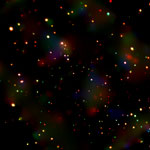 The Chandra Deep Field North: a deep view of the high-redshift X-ray universe from the Chandra X-ray Observatory. Credit: NASA/CXC/PSU/D. M. Alexander, F. E. Bauer, W. N. Brandt et al. Click the image for a larger view. |
Matter Orbiting a Black HoleWhat are the demographics of black hole spin, and what do they tell us about black hole formation and growth? Black hole spin may be a powerful energy source for accretion disks and, especially, relativistic jets. Spinning supermassive black holes may indeed be the ultimate particle accelerators in the Universe, producing some of the highest energy particles. The formation history of black holes is encoded in their spin rates. Both accretion and mergers with other black holes can change their spins. Measuring the distribution of black hole spin for a large number of black holes will determine which mechanisms dominate over cosmic time. At present, there are only a handful of black holes for which tentative observational constraints on spin exist. IXO will measure the width of the iron Kα emission line in hundreds of accreting supermassive black holes systems. These measurements will enable a spin census of black holes, providing a key test of black-hole- and galaxy- formation scenarios. Read more... |
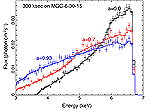 Rotation of the SMBH is expected to produce a "red wing" extending to lower energies in the profile of the Fe Kα. With IXO it will be possible to observe the "red wing" and measure accurately the related amount of black hole spin. Courtesy Laura Brenneman. Click the image for a larger view. |
Neutron Star Equation of StateWhat is the equation of state of matter in neutron stars? Neutron star cores harbor the highest density matter in the Universe. The properties of matter at such high densities is determined by the "strong force"—one of the four fundamental forces of nature. Neutron starts are astrophysical laboratories that give us the unique opportunity to probe the low-temperature, high-density regime of Quantum Chromodynamics (QCD), where a host of novel phenomena associated with QCD phase transitions may take place. More than three decades after the discovery of pulsars, there remains no consensus model for their emission across the electromagnetic spectrum. X-ray polarimetry and spectroscopy with IXO will provide key tests. Read more... |
 High-resolution X-ray spectra of bursting, accreting neutron stars show redshifted absorption lines that reveal the neutron star mass and radius. Courtesy Mariano Mendez. Click the image for a larger view. |
|
Nature of Dark Matter and Dark EnergyHow does galaxy cluster evolution constrain the nature of dark matter and dark energy? Structure formation is a multi-scale problem. Galaxy formation depends on the physical and chemical properties of the intergalactic medium (IGM). The IGM, in turn, is affected by energy and metal outflows from galaxies. Detailed studies of the IGM in galaxy clusters are now limited to the relatively nearby Universe (z < 0.5). IXO will measure the thermodynamic properties and metal content of the first low-mass clusters emerging at z ~ 2 and directly trace their evolution into today´s massive clusters. Precise abundance profiles from IXO measurements will constrain how the metals produced in the galaxies are ejected and redistributed into the intra-cluster medium. Read more... |
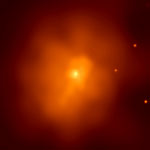 Chandra image of the cluster of galaxies EMSS 1358+6245. Credit: NASA/MIT/J.Arabadjis et al. Click the image for a larger view. |
Cosmic FeedbackHow does cosmic feedback work and influence galaxy formation? Energetic processes around black holes result in huge radiative and mechanical outputs, which can potentially have a profound effect on their larger-scale environment in galaxies, clusters, and the intergalactic medium. The black hole can heat surrounding gas via its radiative output and drive outflows via radiation pressure. Mechanical power emerging in winds or jets can also provide heating and pressure. The high spectral resolution and imaging capabilities of IXO will provide the necessary diagnostics to distinguish between them. Read more... |
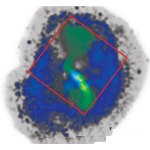
Image of the radio galaxy Hydra A in X-rays with Chandra (blue) and radio with the VLA (green), and the IXO XMS field of view overlaid in red. Adapted from Wise et al. 2007. Click the image for a larger view. |
Missing BaryonsWhere are the missing baryons and do they form a cosmic web in the nearby Universe? Less than 10% of the baryons in the local Universe lie in galaxies as stars or cold gas. The remainder are predicted to exist as a dilute gaseous filamentary network called the cosmic web. Some of this cosmic web is detected in Lyα and OVI absorption lines, but half still remains unseen. Growth of structure simulations predict that these "missing" baryons are shock heated up to temperatures of 107 K in unvirialized cosmic filaments and chemically enriched by galactic superwinds. IXO is required to enable detection of the missing baryons and characterize their velocity distribution along at least 30 lines of sight. Read more ... |
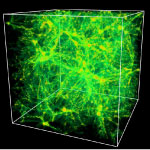 The density distribution of baryons at low redshift from the simulation of Cen & Ostriker (2006). Most of the mass of the WHIM lies within the filaments that connect the higher density regions. Click the image for a larger view. |
|
Origin and Dispersion of ElementsWhen and how were the elements created and dispersed? The dispersal of metals from galaxies can occur as starbursts drive out hot gas that is both heated and enriched by supernovae. This metal-enriched gas is detected with current X-ray missions, but IXO is needed to measure the hot gas flow velocity using high-throughput spectroscopic imaging, and, in turn, to determine the galactic wind properties and their effects. Read more... |
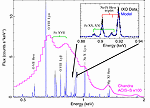 IXO high-resolution X-ray spectra (blue) show the metal-enriched hot gas out flowing from a starburst galaxy, a part of the feedback process unresolvable with current X-ray CCD data (magenta). Credit: David Strickland (unpublished). Click the image for a larger view. |
Particle AccelerationHow are particles accelerated to extreme energies producing shocks, jets and cosmic rays? Most young remnants (Cas A, Tycho, Kepler, SN1006) show clear signs of shock acceleration of electrons in the form of geometrically thin, spectrally featureless rims associated with their high-speed shock fronts. Evidence for the acceleration of cosmic-ray protons has been more difficult to obtain. Understanding how shocks accelerate and heat electrons and ions will require observations of young remnants, synchrotron-dominated ones, and older SNRs, such as the Cygnus Loop, that do not show strong non thermal X-ray emission from their shock fronts. To this end, IXO´s polarimetric and spectroscopic observations will be crucial. Read more...
|
 Color-coded X-ray image of the Tycho SNR. Red corresponds to Fe L emission, green to Si K emission, and blue to 4—6 keV continuum emission. This is derived from the Chandra observations after smoothing with the IXO point-spread-function. Courtesy of John P. Hughes et al. Click the image for a larger view. |
Planet FormationHow do high-energy processes affect planetary formation and habitability? X-ray illumination is likely a critical regulator in the formation and early evolution of planets in the disk. X-ray observations of host stars reveal high-energy inputs to protoplanetary disks and planetary atmospheres due to stellar winds and violent magnetic flaring. X-ray and infrared spectroscopic studies of protoplanetary disks show that X-ray ionization is present, and theoretical calculations indicate its importance to disk thermodynamics, chemistry and dynamics. Read more... |
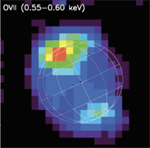 XMM-Newton image of Jupiter in the charge–exchange O VII lines. Courtesy of E. Feigelson et al. Click the image for a larger view. |
Stellar Magnetic FieldsHow do magnetic fields shape stellar exteriors and the surrounding environment? Magnetic reconnection is believed to give rise to a variety of different astrophysical phenomena, from radio and auroral emissions on giant planets to accretion disk flares in AGN. X-ray observations of late-type stars probe the tenuous hot coronal plasma produced by non-radiative heating processes. Read more... |
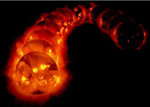 Yohkoh images of the Sun taken over the course of a solar cycle, illustrating the difference in solar coronal structures from maximum to minimum. Courtesy of G.L. Slater and G.A. Linfor, S.L. Freeland, the Yohkoh Project. Click the image for a larger view. |